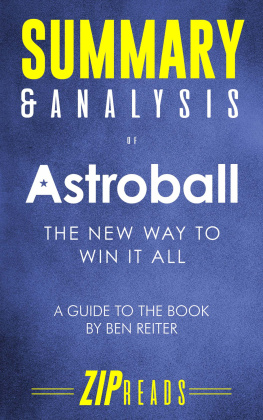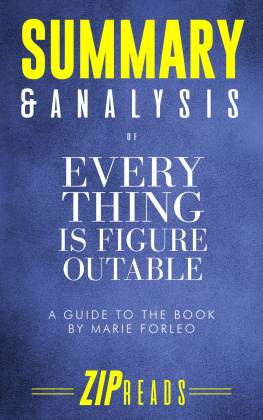
NOTE: This book is a summary and analysis and is meant as a companion to, not a replacement for, the original book.
Please follow this link to purchase a copy of the original book: https://amzn.to/2NQl0qQ
Copyright 2018 by ZIP Reads. All rights reserved. This book or parts thereof may not be reproduced in any form, stored in any retrieval system, or transmitted in any form by any meanselectronic, mechanical, photocopy, recording, or otherwisewithout prior written permission of the publisher, except as provided by United States of America copyright law. This book is intended as a companion to, not a replacement for the original book. ZIP Reads is wholly responsible for this content and is not associated with the original author in any way.
TABLE OF CONTENTS
SYNOPSIS
Astroball: The New Way to Win It All by Ben Reiter immerses you in the front office of a Major League Baseball franchise and shows you exactly what has happened over the past 15 years in terms of the application of analytics to virtually all aspects of the game.
Beginning with the formation of the Houston Astros and proceeding to the involvement of two particular men in the field of analytics, Ben Reiter shares the outlooks of most baseball men towards the use of Big Data and its gradual incorporation around the league.
Focusing on Astros projections for the relative success of draft prospects, and then the improvement of players based on the computer aided study of their mechanics, Reiter shares the practical application of thousands of points of input. Following the teams success culminating in the winning of the 2017 World Series, you see how much value the process holds but also how much farther men such as Jeff Luhnow and Sig Mejdal want to take it.
The key point, however, is the fact that no matter how many 0s and 1s are put into a computer to analyze, the human element provided by scouts, coaches and the players themselves is irreplaceable and also needs to be valued.
KEY PLAYERS
Ben Reiter Feature writer for Sports Illustrated wrote original piece about Astros in 2014 which he added to for Astroball
Roy Mark Hofheinz original owner of the Houston Astros, 19621975
Jim Crane Owner of the Houston Astros, 2010 to present
Jeff Luhnow A management consultant with a strong background in probability, first worked with analytics for Bill DeWitt, owner of the Saint Louis Cardinals then with the Houston Astros under Jim Crane.
Sig Mejdal A student of mechanical and aeronautical engineering with a background in statistics and probability and an interest in psychology, hired by Jeff Luhnow and the Cardinals, followed Luhnow to Houston and ran the analytics departments.
Mike Elias Former Yale baseball player, hired as Special Assistant, then Scouting Director by Jeff Luhnow in 2012 because of his computer literacy and refined skill of observation and analysis of players
Enos Cabell Former MLB player hired by Jeff Luhnow as a scout in 2012
A.J. Hinch New manager for Astros, hired by Jeff Luhnow in 2014
Daniel Kahneman and Amos Tversky Researchers who studied the concept of people making incorrect decisions, even in the possession of valid information that pointed to other options
Kate Bezrukova and Chester Spell Researchers studying the concept of chemistry among workers as a key to better performance
INTRODUCTION
In the first two sections, Ben Reiter provides some background for the inspiration to write this story as well as information about the beginning of the team, the Houston Astros, and their struggle to achieve success.
Key Takeaway: The worst team in baseball became a winner with the use of Big Data.
In June 2014, Ben Reiter, a writer for Sports Illustrated proposed an article to his editor, Chris Stone, about the new program the Astros management was utilizing to improve their team. By incorporating Big Data with the traditional input from scouts, they hoped to ensure the best draft picks to develop a winning team. History bears witness to the success of this approach since the Astros did, in fact, win the World Series in 2017.
Big Data had already been employed in a number of fields such as identifying high crime probabilities, determining the possibility of disease outbreaks, matching people for compatibility, and improving investment success. It would now become part of the process for analyzing a potential players true abilities.
Some of the initial problems with using Big Data included the fact that there was not enough good data or the appropriate algorithms to analyze what was there. The most significant issue Reiter says the experts encountered, however, was the human factor. The gut feelings of the scouts, which traditionally accounted for great recruiting, needed to be incorporated into the findings processed by the computers. The human element included information about the players themselves beyond batting stats and on base percentages.
Key Takeaway:Roy Mark Hofheinz, the owner, neglected the most important part of owning a baseball teamthe talent.
A self-made man who had been born in Beaumont, Texas, in 1912, Hofheinz became a lawyer, legislator and county judge. A millionaire by the age of 35, he then became the Mayor of Houston at 41 and was determined to change the countrys image of the backwater town. Growing from the 68th to the 6th largest city in the United States in roughly 75 years, Houston had become a hub for shipping and industry as well as home to many wealthy people.
In order to make a statement, Hofheinz decided to buy a major league baseball team. To house that team, he filled in a nearby swamp and created the first domed stadium in the country followed by hotels, an amusement park and a huge hall, all of which was named Astrodomain. This proved to be a tremendous draw for tourists since there were many performances by big stars as well as 81 scheduled baseball games, but the team played so poorly, attendance at the Astrodome was minimal. The show he belatedly realized he needed most was the one he couldnt book: a winning baseball team (Reiter, p. 8).
In spite of the fantastic innovations envisioned by Hofheinz, practical issues got in the way of success. The clear dome had to be painted over because fly balls could not be seen, but then the grass died and was replaced by Astroturf, a new invention.
In ten years, from the completion of the Astrodome in 1965 to the astounding debt accrued by Hofheinz by 1975, the team was bought out by his creditors. They managed to enjoy some limited success, but the elusive World Series was still beyond their grasp.
CHAPTER 1: GUT FEELS
Baseball was moving into a new era in which the old style of scouting, recruiting and coaching was changing due to the input of computer generated statistics. Ever since the publication of Moneyball in 2003, clubs began looking at analytics to help them improve their chances at finding top talent.
Compared to others involved in analytics, however, Jeff Luhnow and Sig Mejdal believed just as strongly in the human factor as well, knowing that scouts had always been successful in their own ways. In addition to the innate ability of scouts to find talent, analytics could fine-tune data to back up or even tear down what a scout had to say. Unfortunately, many other team execs were not ready to make the switch and chose instead to do things the way they had always been done.
Key Takeaway: Men with vastly different backgrounds develop the idea that Big Data can be used to improve the composition of baseball teams.
Next page













